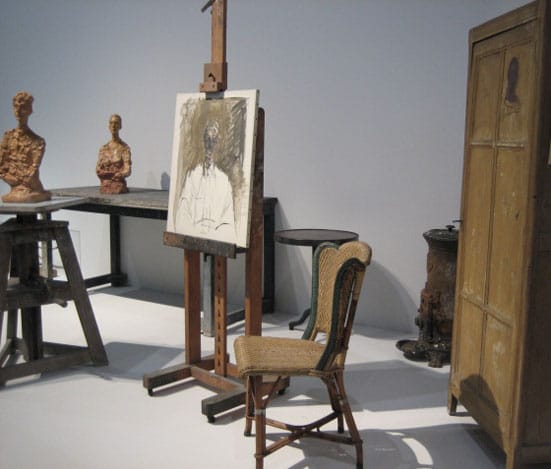The Pompidou Centre in the January sunshine is all sharp edges and flat
colours, and looks as bright and strange as ever against Paris's soft
winter greys. Inside, Alberto Giacometti's archetypal bohemian studio -
gloomy, shabby, and cluttered with art - is exploded into the pristine
emptiness of the sixth-floor galleries. The exhibition brings together
his famous walking figures, tipping precariously forward on their
spindly legs, with the fragments of others, stripped down to their wire
spines, broken up and reworked into near-oblivion. Surrounding these
fierce, fragile pieces there are paintings, sculptures and photographs
spanning the artist's whole life, including busts of his family he made
as a teenager and paintings of the artist as a child by his
Impressionist father. This is a peculiarly personal retrospective, as
interested in the artist's world as in his output. Combining exhibition
pieces with sculptures that were still in the artist's studio when he
died, its real power is in laying bare the chance that calls any single
piece 'finished.' It presents the studio at 46 rue Hippolyte-Maindron
as an artwork in itself: one that the artist never completed after
installing himself there in 1926, and that he only left with his death
in 1965.
Mythologised by Jean Genet in a 1957 magazine article from
which the exhibition takes its title, Giacometti's studio continued to
have a kind of celebrity of its own, part of the artist's identity but
resonant in itself, with its small courtyard, rickety stairs, high
windows and dusty figures in plaster and bronze. A steady stream of
journalists came to probe the interconnectedness of artist and atelier,
and one darkened room brings together hundreds of magazine article,
interviews and photographs of the artist at work in this space.
Photographs by Doisneau, Cartier-Bresson and Brassaï illustrate the
stories, in which Giacometti's craggy face looms out of the shadows
among the sculpted and sketched faces he resembles.
A series of open-plan rooms fans out from this core, spanning the range
of Giacometti's production from his surrealist beginnings and various
incarnations of hard, 'Disagreeable Objects' and impenetrable surfaces.
Throughout his career Giacometti was closely involved with various
kinds of design, particularly through the influence of his brother
Diego, who worked as a designer in the studio next door and served as
model, collaborator, and assistant to Alberto throughout his life.
There are surrealist lighting fixtures on display and one surprising
room displays Giacometti's designs for silk scarves - small outbursts
of colour in an otherwise earthy and monochromatic show. Behind these
stretch rows of sketches for a portrait of Matisse: fragments of the
same face swimming up again and again out of the blank paper.
The sense of Giacometti's immersion in his creative process, and the
endlessness of that process, is overwhelming: his drawings and
sculptures don't seem finished so much as interrupted. Forming a
deliberate, jarring parallel to the room documenting the artist at
work, another central room displays photographs taken just after the
artist's death in 1965, as his famous studio was inventoried and
dismantled to preserve the drawings and carvings that covered the walls
and furniture. Pieces of wall and furniture are displayed here, evoking
Giacometti's total immersion in his space and bearing the traces of his
hands. Several of the dismantling photos include Giacometti's wife,
Annette, alone in the studio. She features in several of the older
photographs, as well as being a frequent model for the artist, but here
her presence registers the shock of his absence. One of the magazine
profiles of Giacometti tells a story in which the 20-year-old Alberto
was staying in the home of a man who was taken ill and died suddenly.
The artist described his sense of death as an ambush, and claimed he
never quite recovered from the suddenness of the man's departure. The
story gets its visual record in Annette's shocked aloneness in the
middle of the studio that was an extension of her husband's mind and
personality.
Giacometti's familiar sculptures - bent forward but rooted to the spot
- always evoke, for me at least, a sense of loneliness and frailty.
Here the tiniest figure stands on a clean white expanse in a glass
cube: a smudge on a page, an insect on a pin. In other exhibitions,
these figures, displayed as refined, finished objects, seem like a
definitive assertion of human isolation. But here, rooted instead in
the space of their creation, surrounded by earlier and later versions,
sketches, maquettes, photographs, and the fleeting image of the artist
at work, they embody the energy and creative life of the studio.
JS

L'Atelier d'Alberto Giacometti at the Pompidou Centre
Photograph: J. Scutts